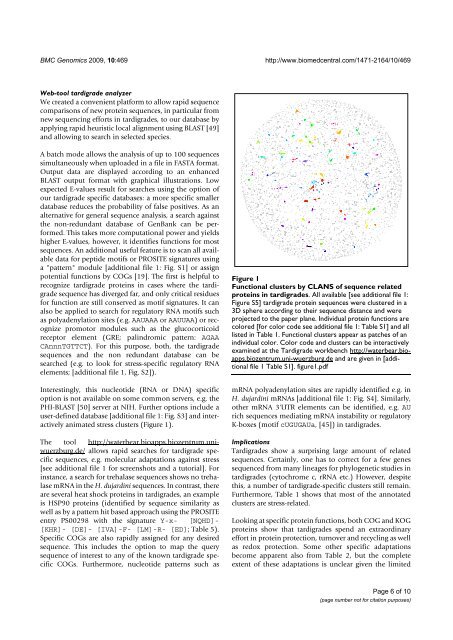Making the most of phylogeny - OPUS - Universität Würzburg
Making the most of phylogeny - OPUS - Universität Würzburg
Making the most of phylogeny - OPUS - Universität Würzburg
Create successful ePaper yourself
Turn your PDF publications into a flip-book with our unique Google optimized e-Paper software.
BMC Genomics 2009, 10:469 http://www.biomedcentral.com/1471-2164/10/469<br />
Web-tool tardigrade analyzer<br />
We created a convenient platform to allow rapid sequence<br />
comparisons <strong>of</strong> new protein sequences, in particular from<br />
new sequencing efforts in tardigrades, to our database by<br />
applying rapid heuristic local alignment using BLAST [49]<br />
and allowing to search in selected species.<br />
A batch mode allows <strong>the</strong> analysis <strong>of</strong> up to 100 sequences<br />
simultaneously when uploaded in a file in FASTA format.<br />
Output data are displayed according to an enhanced<br />
BLAST output format with graphical illustrations. Low<br />
expected E-values result for searches using <strong>the</strong> option <strong>of</strong><br />
our tardigrade specific databases: a more specific smaller<br />
database reduces <strong>the</strong> probability <strong>of</strong> false positives. As an<br />
alternative for general sequence analysis, a search against<br />
<strong>the</strong> non-redundant database <strong>of</strong> GenBank can be performed.<br />
This takes more computational power and yields<br />
higher E-values, however, it identifies functions for <strong>most</strong><br />
sequences. An additional useful feature is to scan all available<br />
data for peptide motifs or PROSITE signatures using<br />
a "pattern" module [additional file 1: Fig. S1] or assign<br />
potential functions by COGs [19]. The first is helpful to<br />
recognize tardigrade proteins in cases where <strong>the</strong> tardigrade<br />
sequence has diverged far, and only critical residues<br />
for function are still conserved as motif signatures. It can<br />
also be applied to search for regulatory RNA motifs such<br />
as polyadenylation sites (e.g. AAUAAA or AAUUAA) or recognize<br />
promotor modules such as <strong>the</strong> glucocorticoid<br />
receptor element (GRE; palindromic pattern: AGAA<br />
CAnnnTGTTCT). For this purpose, both, <strong>the</strong> tardigrade<br />
sequences and <strong>the</strong> non redundant database can be<br />
searched (e.g. to look for stress-specific regulatory RNA<br />
elements; [additional file 1, Fig. S2]).<br />
Interestingly, this nucleotide (RNA or DNA) specific<br />
option is not available on some common servers, e.g. <strong>the</strong><br />
PHI-BLAST [50] server at NIH. Fur<strong>the</strong>r options include a<br />
user-defined database [additional file 1: Fig. S3] and interactively<br />
animated stress clusters (Figure 1).<br />
The tool http://waterbear.bioapps.biozentrum.uniwuerzburg.de/<br />
allows rapid searches for tardigrade specific<br />
sequences, e.g. molecular adaptations against stress<br />
[see additional file 1 for screenshots and a tutorial]. For<br />
instance, a search for trehalase sequences shows no trehalase<br />
mRNA in <strong>the</strong> H. dujardini sequences. In contrast, <strong>the</strong>re<br />
are several heat shock proteins in tardigrades, an example<br />
is HSP90 proteins (identified by sequence similarity as<br />
well as by a pattern hit based approach using <strong>the</strong> PROSITE<br />
entry PS00298 with <strong>the</strong> signature Y-x- [NQHD]-<br />
[KHR]- [DE]- [IVA]-F- [LM]-R- [ED]; Table 5).<br />
Specific COGs are also rapidly assigned for any desired<br />
sequence. This includes <strong>the</strong> option to map <strong>the</strong> query<br />
sequence <strong>of</strong> interest to any <strong>of</strong> <strong>the</strong> known tardigrade specific<br />
COGs. Fur<strong>the</strong>rmore, nucleotide patterns such as<br />
Functional in Figure tardigrades 1 clusters by CLANS <strong>of</strong> sequence related proteins<br />
Functional clusters by CLANS <strong>of</strong> sequence related<br />
proteins in tardigrades. All available [see additional file 1:<br />
Figure S5] tardigrade protein sequences were clustered in a<br />
3D sphere according to <strong>the</strong>ir sequence distance and were<br />
projected to <strong>the</strong> paper plane. Individual protein functions are<br />
colored [for color code see additional file 1: Table S1] and all<br />
listed in Table 1. Functional clusters appear as patches <strong>of</strong> an<br />
individual color. Color code and clusters can be interactively<br />
examined at <strong>the</strong> Tardigrade workbench http://waterbear.bioapps.biozentrum.uni-wuerzburg.de<br />
and are given in [additional<br />
file 1 Table S1]. figure1.pdf<br />
mRNA polyadenylation sites are rapidly identified e.g. in<br />
H. dujardini mRNAs [additional file 1: Fig. S4]. Similarly,<br />
o<strong>the</strong>r mRNA 3'UTR elements can be identified, e.g. AU<br />
rich sequences mediating mRNA instability or regulatory<br />
K-boxes (motif cUGUGAUa, [45]) in tardigrades.<br />
Implications<br />
Tardigrades show a surprising large amount <strong>of</strong> related<br />
sequences. Certainly, one has to correct for a few genes<br />
sequenced from many lineages for phylogenetic studies in<br />
tardigrades (cytochrome c, rRNA etc.) However, despite<br />
this, a number <strong>of</strong> tardigrade-specific clusters still remain.<br />
Fur<strong>the</strong>rmore, Table 1 shows that <strong>most</strong> <strong>of</strong> <strong>the</strong> annotated<br />
clusters are stress-related.<br />
Looking at specific protein functions, both COG and KOG<br />
proteins show that tardigrades spend an extraordinary<br />
effort in protein protection, turnover and recycling as well<br />
as redox protection. Some o<strong>the</strong>r specific adaptations<br />
become apparent also from Table 2, but <strong>the</strong> complete<br />
extent <strong>of</strong> <strong>the</strong>se adaptations is unclear given <strong>the</strong> limited<br />
Page 6 <strong>of</strong> 10<br />
(page number not for citation purposes)

















